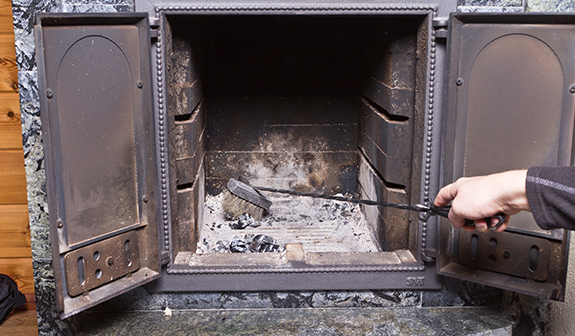How well do creosote sweeping logs actually work?
It sounds like a cheap and easy fix: Simply burn a creosote sweeping log in your wood-burning fireplace or woodstove and your creosote worries will be gone in minutes. But do creosote sweeping logs work like they claim? The answer is yes … and no.
Wood-burning fireplaces are extremely popular in Southeast Michigan homes. Nothing beats coming in from a cold winter’s day and warming up in front of a crackling wood fire. However, burning wood in a fireplace can lead to a potentially dangerous buildup of creosote – a highly flammable, tar-like residue that collects in fireplace pipes. Creosote fires are a major cause of house fires in our area, and it’s imperative that fireplace and woodstove chimneys are regularly cleaned to keep you and your family safe.
Getting back to the question of “do those chimney sweeping logs really work?” the first part of the answer is yes, they do work – to some extent. These types of logs contain a chemical catalyst with can reduce the early stages of creosote buildup up to 60% with repeated use. (Note that there are three stages of creosote buildup: Stage 1 is a flaky soot that can be easily brushed away. In Stage 2, the flakes contain hardened tar which typically can only be removed with specialized rotary tools. In Stage 3, the creosote has turned into a tar-like glaze that in many cases requires replacing the chimney liner.)
But can those logs replace a chimney cleaning performed by a professional service? The answer is a resounding “NO!”
Why You Need a Professional Chimney Cleaning
A chimney cleaning performed by a licensed professional goes well beyond the results produced by a chimney sweeping log. A professional deep-cleaning process includes:
- Removing the highly combustible creosote produced by burning wood and wood products. This includes the debris that may be left by chimney sweeping logs. Many chimneys are not constructed in a straight path from the firebox to the outside. If chimney sweeping logs perform as claimed and cause debris in the chimney to fall, that debris must still be removed from the smoke shelf, baffle, catalytic combustor, or offset in order to ensure a safe and properly functioning chimney. You can learn more about chimney/fireplace construction and maintenance here.
- Eliminating the build-up of soot in coal- and oil-fired systems.
- Removing bird and animal nests, leaves, and other debris that may create a hazard by blocking the flow of emissions from a home heating appliance.
But there is yet another benefit to having your chimney professionally cleaned on a regular basis – and it’s one that could save your life. A thorough, professional cleaning also includes an inspection which could reveal potentially hazardous situations such as breaks or breaches in the flue. Regular cleanings and inspections can alert you to problems before they become dangerous.
Staying Safe with a Wood-Burning Fireplace or Woodstove
There is no substitute for having your chimney cleaned and inspected by a licensed professional at least once a year. Additionally, you should follow these safety tips so you can enjoy your fireplace without worry:
- Only burn seasoned, dry wood.
- Have working smoke alarms on each level of your home and outside all sleeping areas.
- Have a home emergency escape plan and practice it.
- If you have a chimney fire, evacuate your home and call 9-1-1.
Contact Doctor Flue!
Before you light your next fire, make sure your fireplace and chimney are safe and sound by calling Doctor Flue and scheduling a thorough inspection! Contact us online or give us a call us at (800) 438-3583 to schedule your appointment today!
Connect with Doctor Flue on Social Media!

